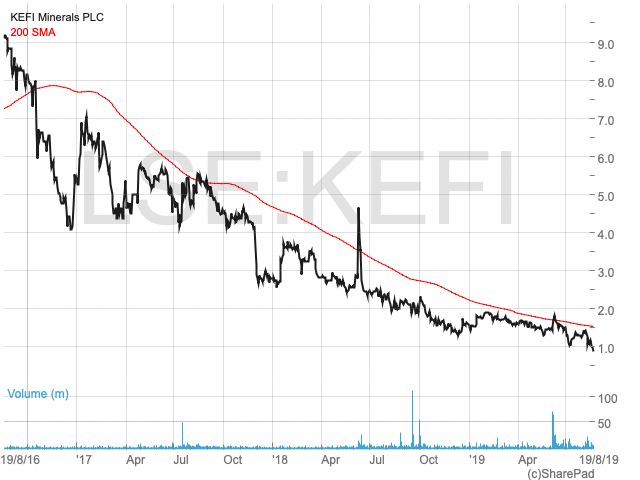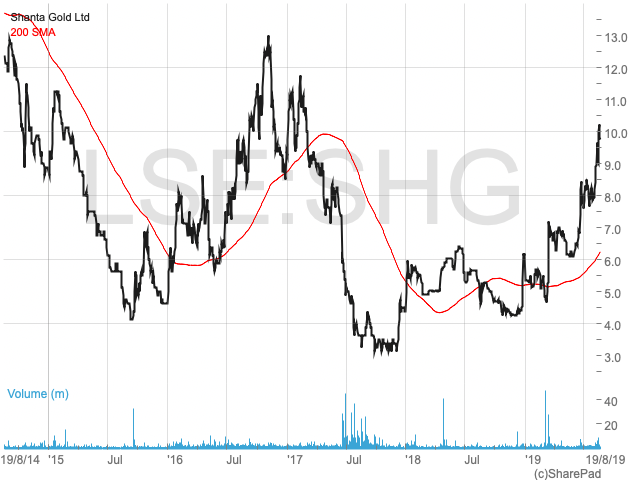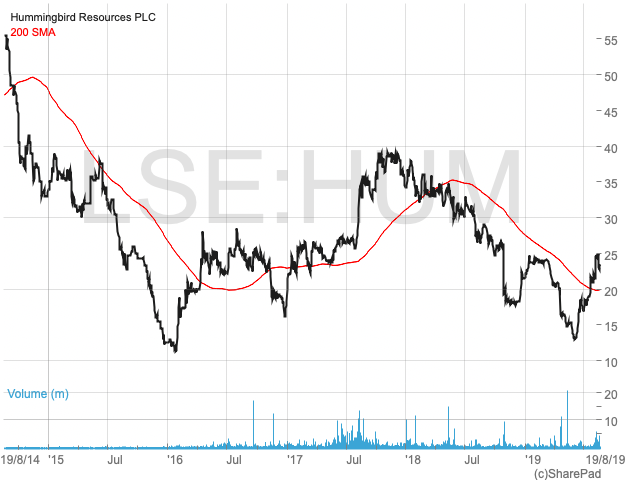Why I’m buying Shanta and keeping an eye on Kefi but avoiding Hummingbird

On the principle that a rising gold price should benefit all gold miners, I don’t want to deter investors from any one of them. But it’s worth bearing in mind what had been affecting sentiment for some before gold took off.
Kefi Minerals (LON:KEFI) (£6.5m market cap @ 0.95p), for example, has its almost ready-to-go 1.7m oz, and practically fully financed, Tulu Kapi mine in Ethiopia on the gold-prolific Arabian/Nubian shield.
In addition, it has an exploration project in Saudi Arabia on the same geology, which starts drilling next month on what Kefi describes as a ‘large copper-gold’ target.
At a $1,400/oz gold price, the most recent DFS (definitive feasibility study) indicated that Kefi’s planned 45% share of Tulu Kapi’s cash flow (after all other partners have subscribed as promised and debt has been secured) will be worth a NPV8at the start of a seven-year production life amounting to $112m (16.2p per Kefi share). At the present $1,500, that value would have more than doubled.
And unlike many broker-touted ‘targets’ based on NPVs, this is more genuine because full financing is (almost) taken into account.
So why are Kefi’s shares approaching an all-time low?

Kefi Minerals – last three years
As it is, after many years of delays not of its making, and many share issues to keep the lights on that have diluted their holdings, investors seem to have given up hope that Tulu Kapi will ever get off the ground as it was targeted to do last month, or that if it eventually does, there will have been more share issues.
However, full government backing was confirmed in March, as was the Ethiopian Central Bank’s support. Funding for the full circa $200m build cost is totally in place, except for a vital $11.4m initial instalment from a key backer, the company’s mining contractor Australia’s ANS Mining, who has delayed paying while a review of security at the mine (promised very soon) is completed.
| Master Investor Magazine
Never miss an issue of Master Investor Magazine – sign-up now for free! |
That review follows on from what held up the mine for two years – namely the political situation in Ethiopia. While the unrest and states of emergency have ended after widespread government reforms, an attempted coup in June in one of Ethiopia’s distant provinces revived some jitters (eg the US Embassy issued advice to visitors to ‘Exercise increased caution due to sporadic civil unrest and communications disruptions’) which prompted Kefi to instigate that review along with the government.
If, as Kefi hopes, it proves satisfactory, ANS’s first instalment will trigger all the other elements of the finance package and enable mine construction to start in November, so that first production can be achieved in 2021.
If not for this latest snag, expectations of production looming relatively soon would already, as for most mining start-ups, have seen Kefi’s shares a good way towards their true stockmarket value. I would put that at 5p per share (while a good guide, shares never even approach their theoretical NPV value, for reasons I’ve explained elsewhere but which most brokers’ analysts – paid to ‘puff’ shares and not to be realistic – are careful to avoid).
There is still the danger before 2021 of more share issues and to convert some loan notes. But if all now goes well, this should not, as has been the case up to now, be a problem for the shares. Kefi looks to me to be one of the best ‘bets’ around (with some risk that ANS still won’t be reassured) especially given the Saudi Arabian prospect to fall back on even if Ethiopia goes up in smoke.
Shanta Gold (LON:SHG) (£79m market cap @10p) in Tanzania has had its share of trouble with the government (who owes it $25m in VAT repayments that Shanta dares not hope it will ever get) and has also built up some large borrowings (which are reducing but with some way still to go) to fund extensions to its mining operations.
The August 12th interims were reasonably good and gold production was 11% higher over the year, so in light of its relatively low $530/oz cash costs and a rising gold price, investors might wonder why SHG’s shares until recently were well under the 12p peaks reached in 2014 and 2016 just before gold took a tumble to the $1,200/oz range.

Shanta Gold – last five years
The answer is that its commitment to repay those large borrowings caused Shanta to hedge its gold sales, so that last March it still had to honour a commitment to sell 45,000 oz (just over half annual output) at $1,230/oz. So, whatever the gold price does from now on, Shanta will benefit from less than half of it (for this year at least, or until it pays the hedge off).
While its New Luika mine with a 1/2 million ounce gold reserve is about to see increased output after more investment, Shanta has long held another attractive but smaller gold deposit at Singida which it has not had the funds to build, although exploration drilling has enabled an economics estimate of a $33m NPV with rapid payback, for a $20m capital investment.
So, the company is pursuing an IPO next year on the Dar es Salaam exchange to raise a targeted $15-20m, following which it expects to retain a 51% share. It has already received a promise from a local conglomerate for a $10m loan facility which, along with the equity raise, would fund all the required capex. On a successful flotation its value would be credited to Shanta’s own balance sheet, helping the current reduction in gearing and probably further improving its rating.
Against this is the large amount of loan repayments still outstanding, but which could be cleared in a short time depending on how far the gold price recovers, as also could the outstanding gold hedge. But, as for the chance that the Tanzanian Government might repay that VAT, I wouldn’t count on it.
Hummingbird Resources (LON:HUM) (£82m market cap @ 23p), despite being in production for two years now at its Yanfolila mine in Mali, was very weak until gold perked up two months ago. So should that be a warning to anyone thinking of buying in to its present short recovery phase, assuming it will continue to follow gold up?
The reason for HUM’s weakness was that, having been flagged in 2015 (as also here in MI) for the apparently strong economics of the Yanfolila near term gold development in Mali, which it had bought very cheaply the year before, the company subsequently damaged its value for shareholders by issuing far more shares to fund the mine’s capex than anticipated, causing them to lose half their value by the end of the year.
However, like all miners do as construction progresses and production nears, the shares staged a recovery over the next two years until they reached a level that a significant original financial backer obviously thought fully reflected their true value, following which various brokers puffed the shares (in at least one case with a totally bogus ‘target’) in order to dispose of those being unloaded.
The result was a spike as private investors snapped up what they thought was the good value those brokers were touting.

Hummingbird last five years
So what was that good value? And why did it unravel?
Those brokers were basing their recommendations on cherry-picked comparisons with other miners without pointing out that for Yanfolila’s short mining life and its small size, they were inappropriate, and without calculating that, even for their favourite ‘puffing’ wheeze (based on a mine’s NPV) the shares had become too expensive. Along with the fact that the earlier heavy equity fund raising had enabled HUM to complete its funding by way of a large bank loan, the latter’s repayment also started to weigh on the shares.
In other words, HUM is a classic case whereby investors – and less than reliable brokers whose only interest is commission on selling shares – failed to do the proper sums to forecast the near future. (Interesting is that a fresh May 2018 puff ‘targeting’ 50p by new broker Cannacord failed to halt the slide!)
| Master Investor Magazine
Never miss an issue of Master Investor Magazine – sign-up now for free! |
It makes no difference that, for the period when Yanfolila (or any short life project) works through its gold, it appears to be extremely profitable and generates cash which builds up, and is the reason why some investors even now think indicates excellent value. All that is actually happening is that the NPV (which last year was fully reflected in the share price) is being converted into cash or dividends, which – the key issue usually ignored – will have to be redeployed into exploring in order to extend the mining life.
It’s not that HUM hasn’t got options to do so. It has been exploring around Yanfolila to find more gold, of which there are encouraging signs, and also has another, larger, gold prospect at Dugbe in Liberia next door. So, given Yanfolila’s short life, the real question for HUM has always been how much will it cost to develop those fresh prospects, and when will they start to contribute?
Dugbe has been on hold for some time (because of its cost) and has a gold resource 90% larger than Yanfolila, but at only 60% the grade, making it more expensive to mine. That shows in its NPV10 of $186m at a $1,300/oz gold price, so that for only 20% more than Yanfolila’s NPV, Dugbe’s capex will be three times higher, meaning it won’t be so easily financed.
HUM’s latest half-year results looked good, showing that Yanfolila poured 28% more gold compared with the previous six months which was hampered by weather, while reducing its all-in cost to $998/oz. But cash holdings had decreased by the same amount as loans outstanding, but which if present trends continue could be fully repaid by June 2021.
Another apparently good forecast was that HUM expects to produce 20% more gold in 2020 than was budgeted in the original 2016 mine plan. However, that is just before Yanfolila’s production is due to tail off unless more gold is found, and when the cost of doing so, and of replacing Yanfolilla with Dugbe, will be looming.
So, if gold continues on up, some investors will no doubt push HUM’s shares higher, but they will need to consider whether the extra cash generated will be enough to pay for those future costs. For that reason, I don’t think any institution will be buying.
To sum up…
I’m buying Shanta. I’m keeping a close eye on Kefi. But I’m avoiding Hummingbird!

Comments (0)